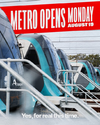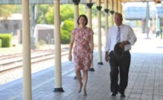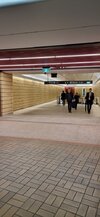Matt O'Sullivan has been one of the fiercest critics of metro over the years and the SMH's articles have been mostly critical. Their comments section to articles have been seriously edited to back their views.
But, now that the metro is opening, wow, how he has changed his tune in the past few days. I suppose a negative view of a positive story now won't get him the clicks he was hoping for, so he's now on the bandwagon. Another knob journalist.
However, finally a decent article nonetheless.
And yes, it is a long article, but a good insight as to how Sydney finally got a seriously modern piece of infrastructure to keep the city in touch with other modern world cities.
The best thing is that there are more metros to come.
Part 1 of the article.........
From SMH:
https://www.smh.com.au/national/nsw...y-harbour-became-reality-20240402-p5fgos.html
How near impossible plan for mega-metro line under Sydney Harbour became reality
By
Matt O'Sullivan
August 16, 2024
Nestled in a historic art deco building, Rockpool and Spice Temple’s bars, restaurants and private dining rooms are destinations for corporate A-listers in Sydney’s CBD. In their exquisite interiors, staff go to great lengths to satisfy their wealthy guests.
Yet more than five years ago, a mega-rail project being carved out beneath their feet raised fears of disruption above. Large equipment excavating a temporary access tunnel to giant station caverns below risked causing vibrations and smashing expensive glassware in the bars and restaurants. The project team suggested Rockpool staff move glasses further apart. It averted disruption to Rockpool, but a few glasses in Spice Temple rattled from a sideboard and broke.
It illustrates the intricate work undertaken on a massive scale over the past seven years during construction of the
$21.6 billion Metro City and Southwest rail line under Sydney Harbour and the heart of the city. In the north, the need to drill emergency cross passages between twin rail tunnels beneath Royal North Shore Hospital at St Leonards presented enormous challenges for engineers because of patient sensitivity to noise and vibrations around the clock. “The timing of those works and how they were managed and the respite period, just for those few cross passages, became a whole exercise in itself,” recalls Hugh Lawson, the Brit who has steered the mega rail project for the last seven years.
Concealed from prying eyes for years, the staggering scale of the new underground rail line will be unveiled on Monday when the line opens, in an act akin to unwrapping a giant present for the city. Carved out of sandstone, the fully automated railway is an engineering marvel that will reshape suburbs close to its stations and the way people traverse Sydney.
Yet, the mega project is about
$10 billion over budget and the final piece – a 13-kilometre stretch from Sydenham to Bankstown in the city’s south-west – will be at least a year late opening. Critics fear that the new railway’s benefits will fail to match its eye-watering price tag, and are scathing of the project’s problem child: the conversion of the century-old Bankstown rail line into one for driverless metro trains.
Forty-five years after the opening of the last railway to be built under the Sydney CBD, commuters will be whisked at up to 100 kilometres an hour on single-deck trains between six new underground stations, as well as giant new platforms beneath Central Station. In a sign of the scale, the twin rail tunnels under the harbour and CBD span 15.5 kilometres from Chatswood to Sydenham. To ensure services run every four minutes in peak periods, the size of the fleet has been doubled to 45 trains, which are housed in giant rail yards in Sydney’s northwest and at Sydenham.
The new line forms the second stage of Sydney’s computer-driven rail network, acting as an extension of the Metro Northwest railway between Tallawong and Chatswood which opened in 2019. Together, the railway to be
known as the “M1” will extend 66 kilometres from Rouse Hill in the northwest to Sydenham in the south, and eventually onto Bankstown.
“It’s the biggest city-shaping investment that has happened in 100 years and the community is yet to fully understand the impacts it is going to make,” says Rob Stokes, a former NSW planning and infrastructure minister who oversaw Sydney Metro before he quit state politics in early 2023.
To his mind, the new line is a bigger deal than the construction of the Harbour Bridge. Stokes argues that the bridge inevitability had to be built to link the city’s north and south, whereas the metro line was never guaranteed. “The metro is an entirely different way of conceiving how to develop the city,” he says. “The coathanger was transformative but ultimately inevitable. The metro is transformative but the decision to do it was never inevitable. It required many hard choices.”
After the final piece of Sydney’s Metro City and Southwest project opens late next year, the ribbon is due to be cut on a
new metro line to Western Sydney Airport in late 2026, followed six years later by the
Metro West railway under the city’s east-west spine between the CBD and Parramatta.
Costing $65 billion, Sydney’s metro network is one of the world’s largest rail projects, rivalling the 200-kilometre expansion of Paris’ rapid transit system. Known as the
Grand Paris
Several months before the 2011 NSW election, the then-head of the state’s transport agency, Les Wielinga, walked into a meeting with shadow transport minister Gladys Berejiklian who had asked to catch up. “I’ve got to admit, I was fairly nervous when I walked in. The [Coalition] policy was to put heavy rail out to the northwest. I believed that to be wrong,” he recalls. “It took until about six months after they got in for us to get the decision for cabinet to make it metro rather than heavy rail.”
In October 2011, Berejiklian first briefed new premier Barry O’Farrell on an option for a metro line instead of a railway for double-deck trains. Eight months later, O’Farrell and Berejiklian called a press conference to
unveil a major shake-up of Sydney’s rail network. In
Sydney’s Rail Future blueprint, Berejiklian detailed
plans in June 2012 for a metro-style, single-deck train system to the northwest, and an eventual second harbour train crossing. It was an abrupt U-turn on the Coalition’s election promise 15 months earlier to build a rail line to Sydney’s northwest as an extension of the existing double-decker train network.
The metro plans had been difficult to gain approval from inside government, and met deep cynicism from the media and the public after the previous Labor government’s metro plans were aborted. The internal rift was evident in the strain between senior Transport officials and Treasury bureaucrats over the blueprint’s wording. “There was a lot of tension as to whether it said ‘across the harbour’ or ‘under the harbour’,” recalls Peter Regan, a former senior Treasury official who is now Sydney Metro chief executive. “Treasury was certainly of the view that it should be above [the harbour], not below.”
Treasury’s fear was that tunnelling under the harbour would be more costly than building a line over the Harbour Bridge. “There was a massive kind of conjecture as to whether or not that was a credible thing to be building,” Regan says. “It was contentious because it’s a big call. That was a project way beyond what anyone had done for a long time. There was always a question mark around how it would get done, but also the timing and the dates.”
In the end, Berejilkian and transport officials prevailed: the blueprint envisaged a “new tunnel under the harbour”. Yet, it did not end the internal brawling with Treasury to turn plans for a metro rail line under the heart of the city into reality. “There was blood on the floor on a couple of occasions,” Les Wielinga recalls. “It’s a massive project. And it’s been built in some of the toughest construction environments you could imagine.”
It also ushered in a bruising period between the Berejiklian camp and Infrastructure NSW, an agency the new government had set up to advise on where and how to spend money on major projects. “[Infrastructure NSW’s] Paul Broad and Nick Greiner were very, very fixed on building the road network ... rather than rail,” Wielinga says.
In mid-2013, the well-regarded public servant
retired due to health reasons. Wielinga left behind a tight team spearheaded by the northwest rail link project head Rodd Staples, senior Transport official Carolyn McNally, rail strategy head Gary McGregor and Berejiklian’s chief of staff Larry McGrath.
In the early days, the mega rail extension project was referred to as Sydney Rapid Transit, and for a time within top government circles was known as Crosslink, before it was publicly badged Sydney Metro City and Southwest. The Coalition government took small steps over several years towards revealing it to be a full-blown metro rail system, trying to avoid people drawing parallels with the Keneally government’s failed
CBD metro rail plans.








